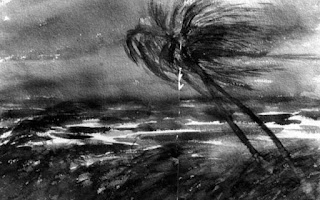 |
| This Federal Art Project painting of a Miami hurricane was created by Robert W. Burke. Credit: Florida Memory |
With Hurricane Matthew a fresh memory, what else can I write about but stormy weather? We had time to prepare: we boarded up windows, removed or secured yard items, stocked up on supplies, and prepared evacuation kits in hopes we wouldn't need them. Then we watched The Weather Channel and local TV forecasters until the power went out.
Imagine not having warning systems. If there's any bright side to a hurricane, the advance forecast has to be it. Pioneers didn't have such a luxury. In Florida's Hurricane History (University of North Carolina Press, 1998; newer editions have been issued since then), author Jay Barnes writes that "Early hurricanes usually barreled ashore without warning, often with dire consequences." (32)Barnes explains how early residents watched cloud formations, sunrise colors, and animal and insect behavior for signs of approaching bad weather. Behavior was said to include:
- a cat's nervous tail twitching
- wandering livestock
- shorebirds gathered together
- bees returning to a hive
- low-flying swallows, bats, geese and ducks
Barnes points out that such "questionable forecasting methods" weren't much help. What did help was the scientific research done by a Jesuit priest named Father Benito Viñes in Cuba. Barnes says Fr. Viñes was "the person who did the most to advance the early understanding of hurricanes ..." (33).
From the 1870s until his death in 1893, the Spanish priest studied the storms and created a warning system that relied on volunteer observers, ship reports, and storm alerts issued by horseback and telegraph. USA Today calls Fr. Viñes the hurricane priest in the headline of a 2014 article about the scientist-priest.
The U.S. Weather Bureau was formed in 1891. Four years later, in 1895, the Bradford County Telegraph in northern Florida featured an article about the department of agriculture's "new plan for the dissemination of hurricane warnings." The system consisted of steam vessels that would fly flags and blow whistles. Telegraphs also were used, but as the newspaper stated, only one line ran along the east coast "and in almost every hurricane communication is very soon destroyed."
Really, the 1895 system sounds similar to the one devised by Fr. Viñes. He deserves better name recognition. Here's a video so you can start learning about him: |
| This screengrab is from a video by Belen Jesuit Prep, which inducted Fr. Viñes into the school's Hall of Fame |

No comments:
Post a Comment